|
French
Romanian |
 |
THE OUTER WALL PAINTING CHURCHES OF NORTH MOLDAVIAby DOINA MÂNDRU |
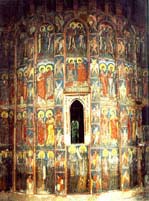 |
Usually built on the site of earlier monasteries, the outer fresco Moldavian
churches date from the 16th century, more precisely from the period after 1530.
During that time more churches built by Prince Petru Rareș (1527 - 1538; 1541 -
1546) and by other important boyars of the country were adorned with marvellous
outer frescos.
Nevertheless it is true that for certain churches from the 15th century
(Old Probota, built after 1456; Putna, 1469; Saint Nicholas of Rădăuți, 1481 - 1486;
Saint John of Vaslui, after 1490), there is documentary and archaeological
evidence as to the presence in Moldavia of an outer painting within an
architectural framework. A recent study on the evolution of architecture
identified a certain trend towards simpler facades, practised after 1501, which
is significant for the vast outer church icons to come. Either that these outer
paintings may be considered a local development or that they might have resulted
from a similar trend from Transylvania, Hungary, Austria , Slovenia or
Switzerland , or that they might have expressed the influence of Greek and Serb
churcheswhere the Day of Judgement and the the unsettled Hymn are represented
outwardly, it is undeniable that this Moldavian phenomenon that took place
between 1540 and 1552 on twelve outer wall collections and their replicas, at
Sucevița from 1596 and at Saint Elias from 1643, represents a singular
'aesthetic case' in the entire evolution of post-Byzantine art.
There are four factors defining this phenomenon:
- the creation of new architectural types;
- the existence of a special order from the prince and entirely supported by
him and by the high clergy;
- the drafting of a theme and an original iconographic programme with
explicit messages and goal, rightly designed semantically and artistically, and,
finally,
- the existence of certain workshops and local artists able to meet the
artistic requirements of their masters.
CONSTRUCTION PATTERNS
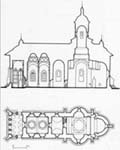
The architectural prototype of these churches was designed in Moldavia along
the 15th century, in a cultural environment influenced by the Byzantine world
and Serbia, where the triconch plan adopted here had originated. Moldavia is
distinct from the Serb pattern by the lack of stone piers flanking the apses and
supporting the bell turret on the naos. Their role is taken over by balancing
arches supported by consoles. In this way the pressure is conveyed to the
buttresses according to the Gothic model; besides, the Moldavian builders found
an original system of narrowing the inner diametre of the turret by means of
more vault arches arranged obliquely or even crossing in the same plan whenever
they support only cupolas. This system is similar to Armenian and Oriental
constructive solutions.
From the point of view of the plan, Moldavian churches take over original
solutions, bringing in a crypt between the naos and narthex (this position never
varies) and, in certain cases -
Humor, Moldovița and Sucevița, -
there is a short room above, a secret precinct or simple vestry. This tendency of a longer plan -
typical of this architecture - is confirmed by the presence of the open porch in
the west part of the churches (Old Moldovița; Neamț, 1497; Saint George of
Suceava; Probota) or that of the enclosed porch (Băilești, 1493; Părhăuți, 1522;
Humor, 1530; Baia, 1532; Moldovița, 1532), which diversifies the architectural
solutions for fulfilling more functions: bell turret, extension of the crypt, a
place for penance, a place for the protection of the entrance and free
communication between the exterior and the interior. A whole range of Gothic
constructive and decorative elements (buttresses, penetration vaults or vault on
ribs, the windownframe pattern inspired by secular architecture), often signed
by workers with symbols identified also on Transylvania sites point out the
originality with which this architecture merges the Byzantine and Gothic
traditions. The outline of the edifices, singled out by the upward broken line
of the multiple joint roof, decisively contributes to defining the specific and
original aspect of this architecture.
DONORS AND BUILDERS
The most important donor of Moldavian outer painting was Prince Rareș. Petru
Rareș, the illegitimate son of Prince Steven the Great (1457 - 1504, the most
famous Romanian princes, sanctified for his having defended Christianity and
Orthodoxism), Petru Rareș was chosen by the boyars prince of Moldavia after the
death of the last direct heir of the great prince. He was not simply concerned
with building monasteries - thus justifying his position of prince both to the
country and to the Ottoman power, Hungary and Poland -, but he also assumed the
role of protector of Orthodoxism, which explains why he married a descendant of
the Serb Branvovics and why he claimed independence. At the same time he
unflinchingly supported Orthodoxism (bitter enemy of the Reformation whose
influenced had begun to be felt during his reign also in Moldavia). Petru Rareș
was a Renaissance prince by his attitude of art patron and modern ruler: he
built Probota monastery, he participated in the construction of Humor
monastery, he also built Moldovița, Baia, Saint Dumitru' (Suceava) and donor of
the outer paintings of Saint George' (Suceava), Pătrăuți and Hârlău (1530)
- the latter lost as e result of last century restoration -, donor of the inner
paintings of Dobrovăț and many other churches (Hârlău, Roman, Botoșani -
here through his wife, Helen -, Târgu Frumos and Vaslui, where the
paintings were not preserved. Two great hierarchs supported him in this
activity: Metropolitan Bishop Grigore Roșca, his cousin, who was to guide him
with the restoration of Probota monastery, himself donor of the narthex and the
Voroneț wall collection and bishop Macarie from Roman, a profoundly spiritual
man with a serious religious education, initiator of the iconographical
programme at Dobrovăț, Râșca, Hârlău, Neamț (narthex and porch),
Bistrița ('Saint John the New ' chapel).
One can state that an ever greater Ottoman danger and the Reformation
pressures were constant concerns. The personal initiative of the prince combined
with the refined aestheticism of the court and taling into account the
moralising role of religious art, as well as the austere life of Moldavian
monasteries generated this unique work of art, the outer paintings of North
Moldavia churches which embodies visibly and immediately this cosmic
'transesperance' of the Church and which allows us through these painted
'ciboires' to contemplate - as Saint maxime puts it - the immaterial Spirit of
the celestial Triumphant Church, the infinite body of cristendom whose members
are all martyrs, Fathers of the Church, Saints and all faithful to the earthly
Militant Church who live through Him and in Him.
THE ICONOGRAPHICAL PROGRAMME
All the specialists who commented on the Moldavian outer paintings agree
that there are subjects whose rendering can be found only here and that there is
a true temptation to copy them on numerous wall collections. Thus there are the
Genesis, the Creation, Adam's Fall, the Banishment from Paradise and, especially
Adam's Contract - a unique representation of the pact with the Devil, where Adam
admits and signs the curse on his descendants.
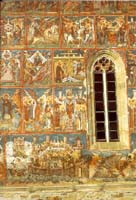 This subject appears at Moldovița on the piers of the west porch (twelve scenes), at Arbore on the west
side (seven scenes), at Voroneț on the north side (fourteen scenes) and Sucevița
also on the north side (eighteen scenes). It is a legend turned into popular
belief , whose rendering results from a bogomile text widespread in the epoch,
copied in the 16th century and known by Rareș himself as the example of the evil
deeds appears and the dangers awaiting humankind whenever it trusts free
thinking or a wrong spiritual guidance. Another subject - treated as nowhere
else - is that of the 'celestial customs', another legend turned into popular
belief , inspired by the life of Saint Vasile the New, known at the time due to
a Moldavian manuscript from the 16th century (manuscript 133 of the Romanian
Academy Library). It can still be seen at all collections entirely preserved
(Probota, Humor, Moldovița, Arbore, Voroneț). This subject is generally painted
on the north face close to the Day of Judgement to which it resembles
symbolically. As regards the Lifespan of Saint John the New (at Saint George's
of Suceava, Voroneț, Sucevița), it stands for a national theme answering the
deep devotion for this saint when after the 15th century his relics were brought
from Suceava. Ever since, Saint John the New has been considered Moldavia's
patron and worshiped as such.
This subject appears at Moldovița on the piers of the west porch (twelve scenes), at Arbore on the west
side (seven scenes), at Voroneț on the north side (fourteen scenes) and Sucevița
also on the north side (eighteen scenes). It is a legend turned into popular
belief , whose rendering results from a bogomile text widespread in the epoch,
copied in the 16th century and known by Rareș himself as the example of the evil
deeds appears and the dangers awaiting humankind whenever it trusts free
thinking or a wrong spiritual guidance. Another subject - treated as nowhere
else - is that of the 'celestial customs', another legend turned into popular
belief , inspired by the life of Saint Vasile the New, known at the time due to
a Moldavian manuscript from the 16th century (manuscript 133 of the Romanian
Academy Library). It can still be seen at all collections entirely preserved
(Probota, Humor, Moldovița, Arbore, Voroneț). This subject is generally painted
on the north face close to the Day of Judgement to which it resembles
symbolically. As regards the Lifespan of Saint John the New (at Saint George's
of Suceava, Voroneț, Sucevița), it stands for a national theme answering the
deep devotion for this saint when after the 15th century his relics were brought
from Suceava. Ever since, Saint John the New has been considered Moldavia's
patron and worshiped as such.
However the main topics of the outer painting occupies large surfaces. These
are: 'The Prayer of All Saints' or "The Great Prayer' - considered by
certain authors to be a hypostasis of the Triumphant Church embracing the
procession of the cherubs, seraphs, prophets, saint fathers of the church,
martyrs and hermits represented on the apses strutting towards hieratium and
which represents the dogma of the embodied word; 'the unsettled hymn'
illustrated in twenty-four stanzas and 'The Siege of Constantinople', an
illustration of the first stanza ('proemium') evoking the happy intervention of
the Mother of God in 626, during the siege of Constantinople by the Persians and
which came to signify an invocation for the victory upon the Ottoman aggressors
- as well as Moses' Prayer and du Buisson ardent, the symbol of the Virgin Mary.
This theme appears at Probota on the south facade , but also at Humor,
Moldovița, Saint George's and Saint Dumitru's (both at Suceava), Baia,
accompanied by "The Siege of Constantinople" scenes (compared, as
explained, with the 1453 events); even at Arbore ( 1541) where the painter notes
the date 626, the painting illustrates the the same episode in a miniature
style, remarkable for its craftsmanship and the number of painted characters.
Without exception, Ieseu's Tree stands close to the illustration of the
stanzas of the unsettled hymn referring to the Annunciation, as at Mass the
invocation of Jesus' ancestors precedes Christmas celebration. The painting
artistry, the seven-stage approach - also containing a vast genealogy of Jesus
and the miracles of the Annunciation, Birth and Cricifixion - prove the special
regard paid to Ieseu's Tree which evokes the intimate link between the Old and
the New Testament, but also the double origin, human and divine, of Jesus
Christ.The Ancient Wise Men, ten, twelve or even fourteen of them painted, at
Saint George's of Suceava, Moldovița, Baia, Voroneț and Sucevița aim at
illustrating the profane testimony of the mystery of the Incarnation;, the
testimony is due, as it is known, to the interpretation of the writing 'on the
Christian key' of Ancient thinking by mediaeval scholasticism.
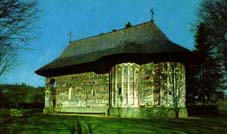 As a peak of the main great themes, the Day of Judgement is, in Moldavia, of
special interest not only due to its echatological and intensely moralising
meaning, but also due to its peculiar approach. At Probota, Humor, Moldovița and
Pătrăuți, the subject matter is inspired by the pattern established in
'Parisinius 74' - known in Moldova through the Four Gospels of Ivan Alexander, a
Constantinople - inspired work from the 14th century - and on the other hand,
the Russian and Ruthenian icons from the 15th century where the motif of the Day
of Judgement appears (Armenians, Latins, Jews, Turks, Tatars). Above all at
Voroneț, the Day of Judgement makes an extraordinary impression on the looker.
Here, as at Saint George's of Suceava, as a matter of fact, the entire vast
facade of the church is painted; deliberately, the church is compact, without
window spaces necessary to light the porch. The glance is first attracted by the
firy rays and the light coming from the purely white clothes of God the Father.
Staring at it, gradually the glance discovers the rest of the composition: the
crowds of the chosen ones, the golden wall of Paradise, Abraham's Garden, and at
the left of the river of the damned ones, the troops of heathens, sent to
expiatetheir eternal punishment, the raising of the dead, given back to life by
graves, the sea and beasts, bugles announcing the Day of Judgement, brilliant
austere angels unfolding new skies, separating darkness from light, good from
evil. The unequalled Voroneț painters represented all this in detail,
thoroughly, taking their time with every single detail of each character of this
glorious painting, according to the idea that any small thing plays its part.
This gives transparence and vigour to the great symbols.
As a peak of the main great themes, the Day of Judgement is, in Moldavia, of
special interest not only due to its echatological and intensely moralising
meaning, but also due to its peculiar approach. At Probota, Humor, Moldovița and
Pătrăuți, the subject matter is inspired by the pattern established in
'Parisinius 74' - known in Moldova through the Four Gospels of Ivan Alexander, a
Constantinople - inspired work from the 14th century - and on the other hand,
the Russian and Ruthenian icons from the 15th century where the motif of the Day
of Judgement appears (Armenians, Latins, Jews, Turks, Tatars). Above all at
Voroneț, the Day of Judgement makes an extraordinary impression on the looker.
Here, as at Saint George's of Suceava, as a matter of fact, the entire vast
facade of the church is painted; deliberately, the church is compact, without
window spaces necessary to light the porch. The glance is first attracted by the
firy rays and the light coming from the purely white clothes of God the Father.
Staring at it, gradually the glance discovers the rest of the composition: the
crowds of the chosen ones, the golden wall of Paradise, Abraham's Garden, and at
the left of the river of the damned ones, the troops of heathens, sent to
expiatetheir eternal punishment, the raising of the dead, given back to life by
graves, the sea and beasts, bugles announcing the Day of Judgement, brilliant
austere angels unfolding new skies, separating darkness from light, good from
evil. The unequalled Voroneț painters represented all this in detail,
thoroughly, taking their time with every single detail of each character of this
glorious painting, according to the idea that any small thing plays its part.
This gives transparence and vigour to the great symbols.
Besides these major themes one can find the lifespans of Saints George and
Nicholas as well as those of the Fathers of Orthodox monasticism - Antonie,
Gherasim and Pahomie and more rarely scenes inspired by the Apostles' deeds (at
Humor, Voroneț - the north facade) or by the Mother of God's life (humor - the
north facade). At Probota, Saint George's of Suceava, Humor, Arbore and Voroneț
the parable of the prodigal son is interpreted as a relaxing moment. This
parable, included in the 'Prayer of All Saints' stands near the unsettled Hymn
or Ieseu's Tree. It is a challenge for a personal eschatological effort and
spiritual endeavours of all believers for Mass celebration. Identifying these
precise links between the illustrated themes and the liturgy calender, M. Taylor
proposed as a virtual sense of Moldavian outer painting this preparation of the
Church itself - as Christ's follower - for the mystery of transubstantiation
illustrated by the painting on the sanctuary apse axis. It is true that the
Incarnation and Christ's Resurrection are eternal symbols of the painting
outside the sanctuary and are sometimes painted again on the porch archways, a
privileged place where the two horizons join together.
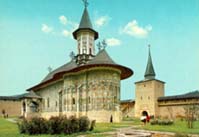 The typology of the North Moldavia wall collections prove that the artists
were locals educated at the school of painting inaugurated by Gabriel Uric's
courtly art, as well as that of wide Byzantine perspective of Thomas of Suceava
- a high official often charged with diplomatic missions abroad and main
Painter of Humor and Moldovița monasteries - or that due to Dragoș Coman, a
painter full of refinement who kew how to combine at Arbore the elegance of
international Gothic with the bright chromatic sounds of Renaissance.
The typology of the North Moldavia wall collections prove that the artists
were locals educated at the school of painting inaugurated by Gabriel Uric's
courtly art, as well as that of wide Byzantine perspective of Thomas of Suceava
- a high official often charged with diplomatic missions abroad and main
Painter of Humor and Moldovița monasteries - or that due to Dragoș Coman, a
painter full of refinement who kew how to combine at Arbore the elegance of
international Gothic with the bright chromatic sounds of Renaissance.
Thus, Moldavian outer painting churches proposed to be included in the World
Heritage List are the following:
'Saint Nicholas' Church of Probota monastery;
The 'Dormition of Mother of God' Church belonging to Humor monastery;
The 'Annunciation' Church of Moldovița monastery;
'Saint George' Church of Suceava;
The 'Saint Cross' Church of Pătrăuți;
Saint George Church of Voroneț
'Saint John the Baptist's Beheading' Church of Arbore monastery.
They illustrate by their authenticity, architecture, by their inner and outer paintings, what they call the golden age
of Moldavian painting or, according to Paul Henry's expression 'the last revival
of Byzantine art'. These churches represent unique mediaeval art treasures by
their icons, embroidery, furniture, precious metal items and the manuscripts
preserved for centuries on end.
This article is reproduced from:
Doina Mândru, Les églises a peinture murale extérieure du nord de la Moldavie, in "Denkmäler in Rumänien/Monuments en Roumanie", ICOMOS- Journals of the German National Committee, XIV, 1995, pg. 81-92;
Translation: Doina Anca Cornaciu; Text Processing: Bodgan Toader
Web: Călin Gligorea;
Electronic Publishing: CIMEC, Bucharest, Mar. 1997.
Last update: January 25, 1999.
|






